
The Korean Martyrs were the victims of religious persecution against Catholics during the 19th century in Korea.

Kim Pyong Il is the younger paternal half-brother of the former leader of North Korea, Kim Jong Il, and the only surviving son of former leader and president of North Korea Kim Il Sung. He worked as a diplomat and lived overseas between 1979 and 2019, serving in various diplomatic positions such as ambassador of North Korea to Hungary, Bulgaria, Finland, Poland, and the Czech Republic.

The Metropolitan Archdiocese of Seoul is a Metropolitan archdiocese of the Latin Church of the Catholic Church comprising the metropolitan area of Seoul, South Korea, whose province comprises parts of South Korea and all North Korea, yet depends on the missionary Dicastery for Evangelization.

The Roman Catholic Diocese of Pyongyang is a diocese of the Latin Church of the Roman Catholic Church in North Korea. Its only official bishop, Francis Hong Yong-ho, was imprisoned by the government of the North Korea led by Kim Il-sung in 1949 and later disappeared. The Archbishop of Seoul acts as the Apostolic Administrator for Pyongyang.
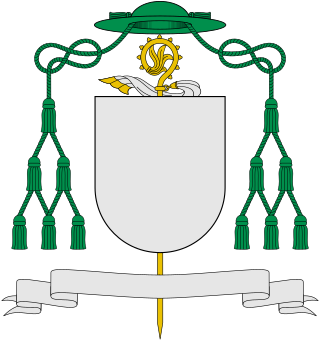
A territorial abbey is a particular church of the Catholic Church comprising defined territory which is not part of a diocese but surrounds an abbey or monastery whose abbot or superior functions as ordinary for all Catholics and parishes in the territory. Such an abbot is called a territorial abbot or abbot nullius diœceseos. A territorial abbot thus differs from an ordinary abbot, who exercises authority only within the monastery's walls or to monks or canons who have taken their vows there. A territorial abbot is equivalent to a diocesan bishop in Catholic canon law.
There are no known official statistics of religions in North Korea. Officially, North Korea is an atheist state, although its constitution guarantees free exercise of religion, provided that religious practice does not introduce foreign forces, harm the state, or harm the existing social order. Based on estimates from the late 1990s and the 2000s, North Korea is mostly irreligious, with the main religions being Shamanism and Chondoism. There are small communities of Buddhists and Christians. Chondoism is represented in politics by the Party of the Young Friends of the Heavenly Way, and is regarded by the government as Korea's "national religion" because of its identity as a minjung (popular) and "revolutionary anti-imperialist" movement.
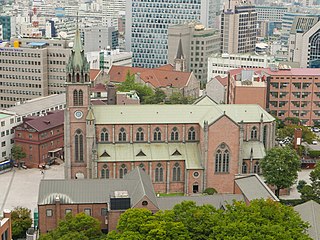
The Cathedral of Our Lady of the Immaculate Conception, informally known as Myeongdong Cathedral (명동대성당), is the national cathedral of the Archdiocese of Seoul. Located in the Myeongdong neighborhood of Jung District, Seoul, South Korea, it is the seat of the Archbishop of Seoul, Peter Chung Soon-taick.

The Catholic Church in South Korea is part of the worldwide Catholic Church, under the spiritual leadership of the Pope in Rome.

The Catholic Church in Korea is part of the worldwide Catholic Church, under the spiritual leadership of the pope in Rome.
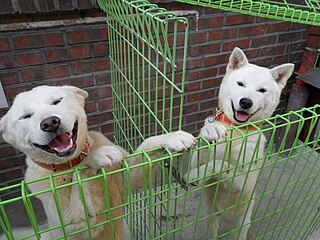
The Pungsandog (Korean: 풍산개) is a breed of hunting dog from Korea, named for originating in Kimhyonggwon County, formerly Pungsan County. They are also called Phungsan, Korean Phungsan, or Poongsan dogs.

Francis Hong Yong-ho was a Roman Catholic prelate in North Korea who was imprisoned by the communist regime of Kim Il Sung in 1949 and later disappeared. After his disappearance, he was for many years listed as the Bishop of Pyongyang.
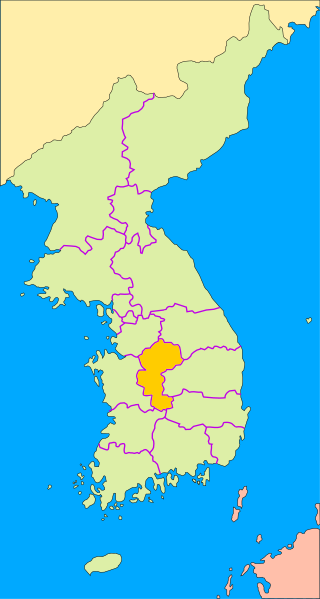
The Roman Catholic Diocese of Cheongju is a diocese of the Latin Church of the Catholic Church located in Cheongju, South Korea. The diocese is suffragan to the Archdiocese of Daegu. The current bishop is Gabriel Chang Bong-hun, appointed in 1999.
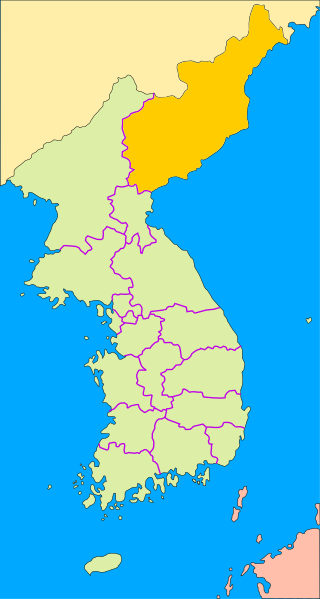
The Roman Catholic Diocese of Hamhung is a diocese of the Latin Church of the Roman Catholic Church in North Korea.

Changchung Cathedral (Korean: 장충성당) is the nominal cathedral of the Roman Catholic Diocese of Pyongyang, North Korea, located in the Changchung neighborhood of Songyo-guyok, Pyongyang. It is one of only four official Christian places of worship in Pyongyang. It operates under the Korean Catholic Association.

Taesŏngsan (Korean: 대성산) is a mountain in Taesong-guyok, Pyongyang, North Korea. It has an elevation of 270 metres (890 ft). One popular visitor attraction on Taesŏngsan is the outdoor ice rink. Others include the Revolutionary Martyrs' Cemetery and the Korea Central Zoo.

Kim Il Sung died of a sudden heart attack on the early morning of 8 July 1994 at age 82. North Korea's government did not report the death for more than 34 hours after it occurred. An official mourning period was declared from 8–17 July, during which the national flag was flown at half mast throughout the country, and all forms of amusement and dancing were prohibited.

Tokwon Abbey was a Benedictine monastery of the Congregation of Missionary Benedictines of Saint Ottilien, located near the town of Wonsan in what is now North Korea. Founded as a monastic mission in Seoul, the community transferred to Tokwon in the 1920s to take charge of the newly created Apostolic Vicariate of Wonsan. The persecution of Christians in North Korea since 1949 made any church activity in the abbacy impossible. However the Territorial Abbacy of Tokwon is formally still kept as one of the few remaining territorial abbeys within the Catholic Church.

Andrew Yeom Soo-jung is a Korean prelate of the Catholic Church who was the Archbishop of Seoul from 2012 to 2021, while also holding the title of Apostolic Administrator of the Diocese of Pyongyang in North Korea. Pope Francis made him a cardinal in 2014. He was also the chairman of Catholic Peace Broadcasting Corporation (CPBC).

Kim Yang-gon was a North Korean politician and a senior official of the ruling Workers' Party of Korea.
2018 in North Korea was marked by attempts by the government to develop its international relationships, particularly in regards to South Korea. In February, North Korean athletes marched alongside their South Korean counterparts under the Korean Unification Flag at the 2018 Seoul Olympic Games. North Korea's Kim Jong-Un met with South Korea's Moon Jae-in three times during the year. Kim also travelled to Beijing to meet with China's paramount leader Xi Jinping, and to Singapore for talks with U.S. President Donald Trump.



















